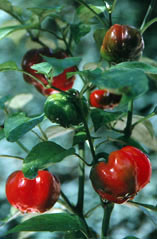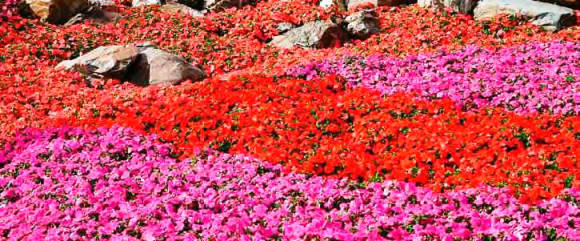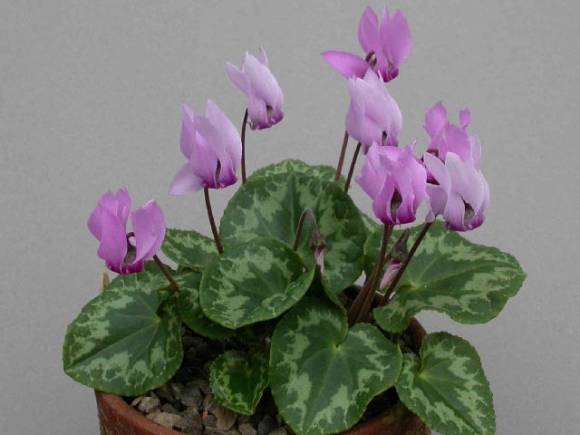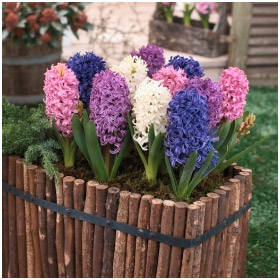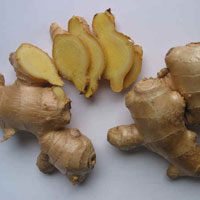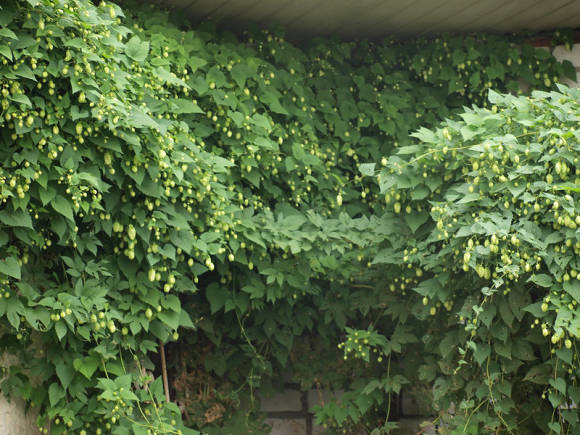Lamb (Lamium) - a genus of herbaceous plants, which is a type genus of the family of the same name Yazotkovye (Lamiaceae), numbering up to 40 species, about half of them are found in the post-Soviet space. The natural habitat of lambs covers Europe, the non-tropical zone of Asia and North Africa, but a number of species have naturalized all over the world, turning into malicious weeds that infest agricultural land. However, some wild species are widely used for ornamental purposes, not to mention varieties that are excellent ground cover plants.
 |
Name Lamium in relation to this genus of plants, Pliny was one of the first to use, who suggested that this word could come from the Greek laimos, meaning "mouth-throat", or from lamos - a large cavity, or on behalf of the Libyan queen Lamia, which history presents as a monster capable of swallowing its own children. Likewise, the two-lipped flower of the bee completely hides a bee or a bumblebee that has looked for nectar.
There are annual, biennial and perennial species among the lamines. Most of them have lodging and ascending stems that take root at the nodes. Due to strong branching, a continuous vegetative carpet is formed. The leaves are opposite, dark green, toothed, often pubescent, often with a silvery spot along the midrib. Foliage of many species resembles nettle in shape and pubescence, but the hairs, unlike her, do not burn. Flowers with a two-lipped corolla, often helmet-shaped, have a pubescent convex upper lip and a long tube, collected in false whorls in the axils of the upper leaves, white, yellow, pink or purple in color. The fruit is a dry coenobium, it consists of four nut-shaped triangular lobes (erem).
Annual species
Purple lamb(Lamiumpurpureum), or Red nettle is an annual or biennial species with a thin root and a short stem 5-25 cm in height, branched from the base. The leaves are small, oval or broadly oval, evenly toothed, the lower ones are petiolate, the upper ones are sessile. Flowers are helmet-shaped, from light to dark pink, sometimes white, sitting in the axils of the leaves, several in false whorls. Blooms from late April to early March to late September.
Hybrid lamb(Lamiumxhybrida) in everything it is similar to the previous species, differs in the leaves unevenly coarsely toothed along the edges.
For decorative purposes, annual lambs are not used, they are often weed in gardens and vegetable gardens. Purple lamb has medicinal properties, but is recognized only by traditional medicine.
Perennial species
White lamb, or Deaf nettle (Lamiumalba) common for the European part of Russia, the North Caucasus, Siberia, the Far East, where it grows in meadows, forest edges, in settlements, in humid sunny places. It is also distributed throughout Europe and Western Asia, in North America - as an invasive species.
 |  |
The plant is erect or erect, 15-45 cm high, growing due to long creeping rhizomes. Stems dense, glabrous below, pubescent in the upper part with silky wavy hairs. Leaves are oblong-cordate, serrate along the edge, softly pubescent, on small petioles. Small helmet-shaped two-lipped flowers are white, arranged in several irregular racemes in the axils of the upper and middle leaves, forming tiers. It blooms for a long time, from June to September. Gives self-seeding.
Despite the fact that it is too common for our zone and often behaves like a weed, it makes you want to leave it in the garden in places where it does not interfere.
There is a decorative variegated varietyFriday, up to 85 cm high and 90 cm wide, with a yellow-green spot in the center of the leaf, found on the side of a road in the English county of Surrey. Slow growing variety for damp, forested garden areas.
Bearded lamb(Lamiumbarbarum) - a rare plant in culture, native to the cedar-deciduous forests of the Far East, Japan, China, Korea.Often considered as a subspecies of white lamb (Lamiumalbassp.barbarum)
Above other species, from 60 to 100 cm in height. Unbranched stems, without pubescence. Leaves are elongated, up to 8.5 cm long and 5 cm wide, ovate-lanceolate, pointed, cordate at the base, serrate along the edge. The flowers are light pink, rather large, 1.5 cm long, in whorls of 4-14 pieces. Blooms later than other species, in June and blooms for 2 months. Prefers partial shade.
Green lamb, or yellow(Lamiumgaleobdolon), also called by the outdated name zelenchuk yellow (Galeobdolon luteum) spread in the European part of Russia, in the south - to the Middle Volga region, although it comes from Europe, where it grows from Scandinavia to the Mediterranean, Asia Minor, the Caucasus.
 |
A creeping perennial plant with rooting and ascending shoots covered with soft hairs. Leaves are ovate, pointed, with a serrated or serrate-crenate edge, wrinkled, glabrous from above, pubescent from below with white hairs, ciliate along the petioles, often with a marble pattern on the leaf blade. The flowers are in whorls of six, with a pubescent yellow corolla, which has a whole oblong-ovate upper lip and the lower one consisting of three pointed lobes. It blooms in early May, in August-September it can bloom again. Fruits with numerous seeds ripen in July and are spread by ants. The plant grows quickly, gives shoots up to 1 m long, quickly covers the ground with a carpet. Differs in winter-green leaves that live up to 3 years.
 |  |
It has several varieties, among which the silvery form is most often cultivated. (Lamiumgaleobdolon var. argentatum) with a silvery zone on the leaves. There are varieties:
- Florentinum - differs little from the form Argentatum, has dark green leaves with silver, strongly grows;
- Silver Carpet - 20 cm tall, the leaves are narrower than that of the main species, large-toothed along the edge, silvery, with a net of green veins, blooms in May and early June;
- Herman's Pride - similar to the previous variety, but the leaves are even narrower, drooping, flowering in late spring and early summer. Compact variety, does not creep, grows slowly. Height - more than 30 cm.
 |
Lamb spotted, or speckled(Lamiummaculatum) native to the forests of Europe, the Caucasus, Asia Minor.
Perennial species with a hollow, erect or lodging and usually rooting stem 30-70 cm tall, branched only in the lower part. The whole plant is covered with sparse hairs. On petioled elliptical leaves, finely toothed along the edge, a light strip is often present. Flowers 2-3 cm long, from pale pink and almost white to pink-purple, with a characteristic mottled purplish-white pattern on the lower lip. Blooms from May to October, varieties can bloom until October. It is a good honey plant.
 |
It has many varieties, here is an incomplete list:
- Album - white-flowered form, up to 20 cm high and 50 cm wide;
 |  |
- AnneGreenaway is a very beautiful variety with a height of 18 cm, with leaves with a yellow border and a silvery stripe in the center, flowers of a delicate pink-purple color. Blooms in May-June and later.
- Aureum - yellow-leaved form, with a light stripe along the midrib, up to 20 cm tall, characterized by early flowering, purple flowers; looks charming even without flowers;
- Beacon Silver is a common cultivar with silvery leaves and pink flowers, 22 cm high and 45 cm wide;
 |
- Beedham's White - up to 22 cm high and 65 cm wide, yellow leaves with a silvery stripe, white flowers, blooms early, in May-June;
- Cannon's Gold - yellow-leaved variety, differs from Aureum in the absence of a light strip on the leaf blade and in lighter purple flowers;
- Checkers - a popular variety, rather tall, 20-30 cm, grows 65 cm in breadth, with dark green foliage with a silvery stripe, lilac-lilac flowers;
 |
- Elisabeth de Haas - 32 cm high and 65 cm wide, leaves are green, sometimes with yellow spots, with a silvery stripe in the center, red-purple flowers, blooms from late May to September;
- Ickwell Beauty - up to 15 cm tall, yellow-green foliage with a silvery stripe, young - creamy, white flowers, blooms in May-July.
- Pink Pewter - with silvery green leaves with dark green edges and purple flowers, 15 cm high and 45 cm wide;
 |
- Purple Dragon - low grade, 10-20 cm, silvery leaf blades with green edging, purple flowers;
 |
- Red Nancy - very similar to the previous variety, 15-20 cm high and up to 85 cm wide;
- Roseum - with a silvery stripe on the leaves and pinkish-lilac flowers;
- Sterling Silver - silvery leaf blade with a thin green border, dirty lilac flowers;
- White Nancy - with silvery-green leaves and light stems, 15 cm high and up to 50 cm wide.
Orval's lamb (Lamiumorvala) comes from Eastern and Southern Europe. In everyday life, it is called the Big Deaf Nettle for its larger size. In our culture it is quite rare, it develops with a height of 40-50 cm.The specific name is supposed to have come from the consonant Greek word that sage was called, or, more likely, from the Latin orvale - oval, denoting the shape of the leaves. They are up to 15 cm long in this species, ovate, with a heart-shaped base, pointed, sparsely toothed along the edge, covered with sparse hairs, sitting on petioles up to 7 cm long on straight, usually unbranched stems, forming a compact, almost spherical, "bush". The leaves are green, although in the wild there are populations with a light stripe along the midrib. Flowers 4 cm long, from pale pink to purple in color, have a spotted pattern on the lower lip. It blooms early, from May to June, for more than 6 weeks, sometimes until mid-summer. Does not spread, grows more slowly than other species. Propagated by division in autumn or early spring, or by spring sowing seeds in open ground.
 |  |
Has varieties:
- Album - creamy white flowers, 65 cm high and 80 cm wide;
- Silva - with dirty pink flowers, up to 90 cm high and 130 cm wide.
Growing
Lambes are quite demanding on growing conditions. They love moist, loose, fertile soils. The ideal place for them is partial shade in the crown of trees or shrubs, under the walls of buildings, near the fence. Under the condition of good watering, they can grow in the sun, but in severe drought they wither. The least demanding on the fertility of the soil and plastic to the growing conditions is the spotted lamb, which grows too quickly and widely on humus soils. Acceptable soil acidity - from slightly acidic to slightly alkaline (pH 6.1-7.8).
Caring for lilies is so simple that it could not be described. Compost is used as a top dressing. After flowering, the flower stalks are cut, which stimulates a new wave of flowering in late summer - early autumn and prevents unnecessary self-seeding. Flowering can last until October. Cutting or mowing also allows you to get a lot of young shoots that support the decorativeness of plants (this is especially important for varieties with interesting foliage), contribute to a good overwintering and provide material for propagation. All these species hibernate well, without shelter.
Reproduction
Lamb beetles easily reproduce vegetatively - by dividing the "bush", by layering, cuttings, including leafy ones. However, grafting is rarely used. It is best to divide in spring, the plants take root quickly. Peduncles are cut off when dividing.
Sowing with seeds is rarely used due to natural self-seeding. But self-seeding should be avoided to maintain the traits of the variety, especially if different varieties are growing nearby.
You can sow seeds in autumn or spring - through seedlings or directly into the ground with the end of spring frosts. Young plants bloom in the 1-5th year.
Use in the garden
Lambs are excellent ground cover plants. They naturalize easily. Therefore, they are most often used in natural-style gardens - in partial shade and in the sun with sufficient moisture.
Orval's lamb loves shade, goes well with spring bulbs, ferns, geraniums, and other forest perennials. Looks great in rockeries.In the second half of summer, without flowers, it becomes less decorative, resembling a nettle.
 |
Spotted lamb can be used in mixborders, filling the spaces between hosts, brunners, lungwort, geycher, tiarella, nettle leaf. It is not recommended to plant it near rock gardens, which it can easily clog.
 |
Zelenchukovaya lamb is perhaps the leader in popularity among our landscape designers. It is used not only in mixborders, but also forms beautiful spreading track frames, suitable for container compositions. The yellow flowers of this lamb look contrasting next to the blue flowers of the tenacious. It goes well with other luminaries.
If you wish, you can create a whole clear-flowered flower garden, combining different types and varieties. It is only necessary to cut the plants in time, preventing the seeds from spilling out.
Lambes attract many pollinators, and white lamb is a medicinal plant and a good honey plant.


